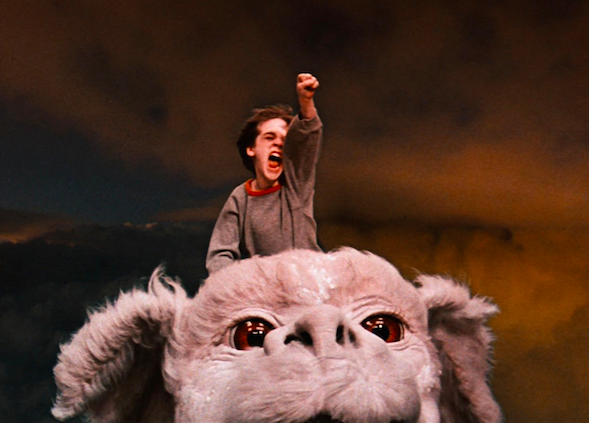1984 at the Movies ● by Craig J. Clark
For evidence of what can happen when Hollywood Gets It Right, one need look no further than the year 1984, which yielded a batch of top-grossing films that also managed the feat of being rather good as films. (The lone exception in the top ten is probably Police Academy, which hasn’t aged well at all, but then again it wasn’t meant to.) Looking back on it from an era when sequels, franchises, and reboots routinely dominate the box office, it’s refreshing to note that only two of 1984’s top ten films were sequels –Indiana Jones and the Temple of Doom and Star Trek III: The Search for Spock. Sure, it’s also the case that seven of the remaining films spawned sequels of their own before the decade was out (the lone holdout, Footloose, had to wait 27 years before it was remade), but one can hardly blame studio execs for wanting to see if lightning would strike twice with properties like Beverly Hills Cop (the #1 film of 1984 by the time the December release finished out its astonishing theatrical run the following summer), Gremlins, The Karate Kid, and Romancing the Stone.
Of course, box office tallies only tell part of the story, which is why the IU Cinema’s “Hollywood Renaissance – 1984” series includes all kinds of cultural touchstones, from effects-driven spectacles to the cultiest of cult films. Topping the list is the film that came in second to Eddie Murphy’s wisecracking Axel Foley: Ivan Reitman’s Ghostbusters (Oct. 25), which is also pulling double duty as a CINEkids screening. A film of such enduring popularity that it received a 30th anniversary re-release Labor Day weekend, Ghostbusters continues to captivate audiences thanks to the interplay of the leads (Bill Murray, Dan Aykroyd, Sigourney Weaver, and Harold Ramis, for those people who have been living in a cave since 1984) and the terrific supporting cast (Rick Moranis, Annie Potts, William Atherton, and Ernie Hudson), not to mention the quality of the script (by Aykroyd and Ramis) that elevates it above the typical Hollywood product. Even the special effects, which were groundbreaking at the time, hold up their end of the bargain. Sure, they may look quaint to an audience reared on digital effects, and the pacing of the action scenes may seem a little slow to anyone who worships at the altar of Michael Bay, but I’ll take quaint over bombastic any day.
Coming in at #12 on the chart is Milos Forman’s Amadeus (Dec. 14), which won Best Picture along with seven other Academy Awards (with three more nominations besides). Based on Peter Shaffer’s Tony Award-winning play, which Shaffer adapted for the screen (taking home an Oscar in the process), the historical comedy-drama tells of the intense rivalry that flares up between established court composer Antonio Salieri (F. Murray Abraham) and talented upstart Wolfgang Amadeus Mozart (Tom Hulce), whose unbridled genius outshines Salieri’s workmanlike efforts. As one might expect, the music adds a great to the film’s power, so hearing the soundtrack through the Cinema’s Dolby speakers should be quite an experience.
Returning to modern times, at #44 is Sixteen Candles (Nov. 16), which was the directorial debut of former National Lampoon writer John Hughes. Previously, Hughes had written the Lampoon movies Class Reunion and Vacation, as well as Mr. Mom, but he was ready to stake his claim to the high-school comedy with Sixteen Candles, which made stars out of Molly Ringwald and Anthony Michael Hall, both of whom stuck around for his follow-up, The Breakfast Club. In this film, Ringwald plays a girl whose sister’s impending marriage causes her family to forget all about her 16th birthday, which would be mortifying enough for more teenagers. On top of that, she’s nursing a crush on the most popular boy in school and has to deal with the crush that the geekiest of the geeks (Hall, playing a character named Geek) has on her. As embarrassing as her plight is, though, it will be interesting to see how it plays compared to the scenes involving exchange student/walking stereotype Long Duk Dong (Gedde Watanabe). That’s one aspect of the film that marks it as a product of its time.
[Image at the top of this post from “Sixteen Candles.”]
●
After Ghostbusters, the other CINEkids offering in the series is #54, The NeverEnding Story (Dec. 7). Directed by Wolfgang Peterson, who was coming off his first international success, 1981’s Das Boot, and based on the beloved children’s book by Michael Ende, The NeverEnding Story is about a boy named Bastian (Barret Oliver) who gets swept up in the saga of Fantasia, a magical kingdom threatened by “The Nothing.” As he follows along with the adventures of Atreyu (Noah Hathaway), who encounters all sorts of incredible creatures, both helpful and malevolent, Bastian finds that by reading the story, he becomes a part of it. One can hope that December’s screening will allow plenty of children (of all ages) to become part of it as well.
The NeverEnding Story
●
As the box-office chart gets down into the hundreds, the selections become more idiosyncratic, although no less influential. For instance, take #112, the Talking Heads’Stop Making Sense (Sep. 24 & 25), which is widely considered one of the greatest concert films ever made. Unlike some that look like they were thrown together on the fly, Stop Making Sense seems like it was meticulously worked out months in advance, but this doesn’t stop it from simultaneously feeling completely spontaneous. In fact, the joy in the performances is so apparent that everybody onstage appears to be having the time of their lives. I suspect this is probably because they were, and director Jonathan Demme and his crew were there (for a three-night stand at an intimate concert hall) to capture every note, look and gesture.
Stop Making Sense famously opens with David Byrne on a bare stage performing a solo acoustic version of “Psycho Killer” to a prerecorded drum machine track. From there, the other members of the band (Tina Weymouth, Chris Franz, Jerry Harrison) are added one at a time and the stage is pieced together in full view of the audience while they run through some of their early material. Once everything (and everyone) is in place, the nine-piece band concentrates on the polyrhythmic songs from the Speaking in Tongues and Remain in Light albums, accompanied by some incredibly striking visuals. (Every song has its own “look.”) The end result is a sight that no self-respecting music- or film-lover should miss.
Stop Making Sense
●
The same goes for #117, This Is Spinal Tap (Oct. 30 & Nov. 6), one of the most quotable movies you’re ever likely to see and a clear forerunner to today’s improvisation-heavy comedies. As devised by director Rob Reiner and actors Christopher Guest, Michael McKean, and Harry Shearer – who wanted the entire cast to receive a screenplay credit, but the Writer’s Guild wouldn’t allow it – the film charts the decline of a once-popular British heavy-metal act as it tours America, playing to dwindling audiences, coping with the disinterest of their American label, and dealing with internal strife. These are merely the dramatic underpinnings that inform one of the funniest underdog stories around, though. Even the songs, which the actors composed and performed themselves, are very funny and quite catchy. This Is Spinal Tap is a film that definitely goes to 11.
Finally, scraping the bottom of the box-office barrel – thanks to a botched release by a studio that had no idea how to market it –is Repo Man (Nov. 14 & 15), which comes in at #166 (out of 168 films released that year). When one thinks of ’80s cult movies, Alex Cox’s debut is one of the first that generally springs to mind. Set in a Los Angeles overrun by punks and hooligans (and where all of the food and drink comes in generic packaging), the film follows an aimless high school dropout (Emilio Estevez) who falls in with a somewhat disreputable group of repo men after being recruited by Harry Dean Stanton, who teaches him the ins and outs of the “repo code” (among other things). Meanwhile, there’s a rogue atomic scientist (Fox Harris) driving around town in a ’64 Chevy Malibu with two dead aliens in the trunk and it seems like just about everybody is after him, especially after a $20,000 bounty is placed on the car.
Cox’s script is fairly episodic, alternating between scenes of Estevez going on repossession jobs with Stanton and Sy Richardson (a much more intimidating mentor, all things being equal), the alien conspiracy plot (which involves a secret government agency, of course), and the criminal escapades of Estevez’s punk friends (who don’t think much of his present occupation). He also finds time to hit on U.F.O. researcher Olivia Barash (who works for the United Fruitcake Outlet) and listen to the wisdom of burnt-out mechanic Tracey Walter (who always takes the bus because he believes “the more you drive, the less intelligent you are”). All the while, cinematographer Robby Müller – who shot Paris, Texas for Wim Wenders the same year – captures the city in all its neon-lit, graffitied glory. As the IU Cinema’s program proves, it takes all kinds to make a film series.



